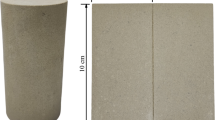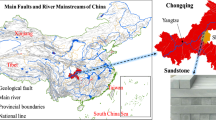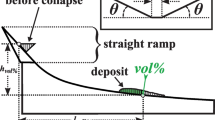Abstract
Because of the large range of pore size distribution and the chemical/mineralogical heterogeneity within shale matrix, gas flow in it may exhibit dual-continuum flow behavior even though rock matrix is not fractured. The relative importance of dual-continuum flow has considerable implications to the shale reservoir characterization and gas production. A matrix-dominant gas flow model is developed to evaluate the impacts of dual-continuum gas flow on gas production. The simulation results reveal three regimes with regard to the relative importance of the dual-continuum flow. When the mass transfer coefficient between the mobile and immobile continua is relatively high, the dual-continuum behavior becomes insignificant within the context of production rate prediction. When the mass transfer coefficient is very small, the dual continuum gas flow behavior also becomes insignificant because gas flow between the two continua is essentially negligible. Thus, the dual-continuum gas flow behavior becomes important to the long-term gas production rate only for the intermediate range of mass transfer coefficient that is shown to depend on porosity and gas adsorption properties. Based on the physical reasoning and numerical simulation results, we propose a criterion to determine the relative importance of the dual-continuum gas flow. The criterion is expressed with a dimensionless parameter that combines several parameters including the mass transfer coefficient, gas viscosity and densities and matrix porosity. The numerical simulation results show that when the dimensionless parameter is less than a critical value, the dual-continuum gas flow becomes important under a variety of different conditions.














Similar content being viewed by others
Abbreviations
- A 0 :
-
A constant in Eq. (16)
- A F :
-
Fracture surface area (L2)
- a v :
-
Interfacial areas between mobile and immobile continua within a unit volume of bulk rock matrix (L−1)
- α :
-
Dimensionless rarefaction coefficient in Eq. (16)
- α 0 :
-
A constant in Eq. (16)
- \(\alpha_{k}\) :
-
The pressure-sensitivity factor for permeability
- \(\alpha_{\phi }\) :
-
The pressure-sensitivity factor for porosity
- B 0 :
-
A constant in Eq. (16)
- B :
-
Apparent mass transfer coefficient defined in Eq. (10) (T−1)
- B* :
-
Mass transfer coefficient defined in Eq. (8) (L2 T)
- d F :
-
Average spacing of fractures that have significantly higher permeability values than the matrix (L)
- f c :
-
A factor that defined in Eq. (13)
- k B :
-
Boltzmann constant
- K n :
-
Knudsen number
- k i :
-
Local gas permeability in the immobile continuum (L2)
- k m :
-
Matrix permeability (L2)
- k 0 :
-
Matrix permeability under the initial reservoir pressure (L2)
- L i :
-
Characteristic length of immobile packets (L)
- M :
-
Molecular mass
- p :
-
Gas pressure (M L−1 T−2)
- p i :
-
Pore pressure in the immobile continuum (M L−1 T−2)
- p m :
-
Pore pressure in the mobile continuum (M L−1 T−2)
- ∆p m :
-
Pressure difference between the current reservoir pore pressure and the initial reservoir pore pressure for the mobile continuum (M L−1 T−2)
- p L :
-
Gas pressure when \(\rho_{a,i} = \frac{{\rho_{L} }}{2}\) (M L−1 T−2)
- p m :
-
Pressure in the mobile continuum (M L−1 T−2)
- p i :
-
Pressure in the immobile continuum (M L−1 T−2)
- p well :
-
Pressure in the horizontal well (M L−1 T−2)
- p 0 :
-
Initial reservoir pressure, (M L−1 T−2)
- π c :
-
A dimensionless parameter defined in Eq. (24)
- q M :
-
Gas mass flux at the fracture-matrix interface (M L−3 T−1)
- q im :
-
Gas mass transfer rate (per unit volume of the porous medium) from the immobile continuum to the mobile continuum (M L−3 T−1)
- R :
-
Universal gas constant in Eq. (11)
- r :
-
Pore throat radius (L)
- t :
-
Time (T)
- T:
-
Reservoir temperature
- x :
-
Spatial coordinate and has zero value at the fracture-matrix interface (L)
- μ m :
-
Gas viscosity in the mobile continuum (M T−1 L−1)
- μ i :
-
Gas viscosity in the immobile continuum (M T−1 L−1)
- ρ :
-
Gas density (M L−3)
- ρ i :
-
Free-gas density in the pores of immobile continuum (M L−3)
- ρ m :
-
Gas density in the mobile continuum (M L−3)
- ρ L :
-
Adsorbed gas density for \(\rho_{i} \to \infty\) (M L−3)
- ρ a,i :
-
Adsorbed gas density in the immobile continuum (or the mass of adsorbed gas divided by the bulk volume of the porous medium) (M L−3)
- \(\phi_{i}\) :
-
Porosity for the immobile continuum
- \(\phi_{\text{m}}\) :
-
Porosity for the mobile continuum
- \(\phi_{\text{t}}\) :
-
Total porosity including both mobile and immobile continuum
- \(\phi_{\text{h}}\) :
-
Portion of the porosity that is not stress sensitive
- \(\phi_{\text{s}}\) :
-
Stress-sensitive portion of the matrix porosity under the ambient condition
- λ:
-
Mean free path
- z:
-
Gas compressibility factor
References
Akkutlu IY, Fathi E (2012) Multiscale gas transport in shales with local kerogen heterogeneities. SPE J 17(4):1002–1011
Amooie MA, Soltanian MR, Xiong FY et al (2017) Mixing and spreading of multiphase fluids in heterogeneous bimodal porous media. Geomech Geophys Geo-Energy Geo-Resour 3(3):225–244
Beskok A, Karniadakis EG (1999) A Model for Flows in Channels, Pipes, and Ducts at Micro and Nano Scales. Microscale Thermophys Eng 3(1):43–77. https://doi.org/10.1080/108939599199864
Bhandari AR, Flemings PB, Polito PJ, Cronin MB, Bryant SL (2015) Anisotropy and stress dependence of permeability in the Barnett Shale. DOI, Transp Porous Med. https://doi.org/10.1007/s11242-015-0482-0
Bustin RM, Bustin A, Ross D et al. (2008) Shale gas opportunities and challenges. In: Presentation at AAPG annual convention, San Antonio
Civan F (2010) Effective correlation of apparent gas permeability in tight porous media. Transp Porous Med 82:375–384
Craft BC, Hawkins MF, Terry RE (1959) Applied petroleum reservoir engineering. Prentice-Hall, New York
Darabi H, Ettehad A, Javadpour F (2012) Gas flow in ultra-tight shale strata. J Fluid Mech 710:641–658
Darishchev A, de Nancy ENSG, Lemouzy P, Rouvroy P (2013) On simulation of flow in tight and shale gas reservoirs. In: Paper (SPE 163990) presented at the SPE middle east unconventional resources conference and exhibition held in Muscat, Oman
Dehghanpour H, Shirdel M (2011) A triple porosity model for shale gas reservoirs. In: Paper (SPE 149501) presented at the SPE Unconventional Resources-Canada held in Calgary, Canada
EIA (2014) Annual energy outlook 2014 with projections to 2040, Technical Report. U.S. Energy Information Administration
Gouth F, Collell J, Galliero G et al. (2013) Molecular simulation to determine key shale gas parameters, and their use in a commercial simulator for production forecasting. In: Paper SPE 164790 presented at the EAGE annual conference & exhibition held in London, UK
Haghshenas B, Clarkson CR, Chen S (2013) Multi-porosity, multi-permeability models for shale gas reservoirs. In: Paper (SPE 167220) presented at the SPE unconventional resources-Canada held in Calgary, Canada
Hu QH, Ewing RP (2014) Integrated experimental and modeling approaches to studying the fracture-matrix interaction in gas recovery from barnett shale. RPSEA Report, University of Texas at Arlington
Kim J, Morridis GJ (2014) Gas flow tightly coupled to elastoplastic geomechanics for tight- and shale-gas reservoirs: material failure and enhanced permeability. SPE J 19:1110–1125
King GE (2010) Thirty years of gas shale fracturing: What have we learned? In: Paper (SPE 133456) presented at SPE annual technical conference and exhibition held in Florence, Italy
Liu HH (2017) Fluid flow in the subsurface: history, generalization and applications of physical laws. Springer, Switzerland
Liu HH, Lai B, Chen J et al (2016a) Pressure pulse-decay tests in a dual-continuum medium: late-time behavior. J Petrol Sci Eng 147:292–301
Liu HH, Ranjith PG, Georgi T et al (2016b) Some key technical issues in modelling of gas transport process in shales: a review. Geomech Geophys Geo-Energy Geo-Resour 2(4):231–243
Liu HH, Georgi D, Chen J (2017) Correction of source-rock permeability measurements owing to slip flow and Knudson diffusion: a method and its evaluation. J Pet Sci. https://doi.org/10.1007/s12182-017-0200-3
Ozkan E, Brown M, Raghhavan R et al (2011) Comparison of fractured-horizontal-well performance in tight sand and shale reservoirs. SPE Reserv Eval Eng 14:248–259
Patzek TW, Male F, Marder M (2013) Gas production in the Barnett shale obeys a simply scaling theory. PNAS 110(49):19731–19736
Ross DJK, Bustin RM (2007) Impact of mass balance calculations on adsorption capacities in microporous shale gas reservoirs. Fuel 86(17–18):2696–2706
Selim MS, Sloan ED (1989) Heat and mass transfer during the dissociation of hydrates in porous media. AIChE J 35(6):1049–1052
Silin D, Kneafsey TJ (2011) Gas shale: From Nanometer-scale observations to well modeling. In: Paper (CSUG/SPE 149489) presented at the Canadian unconventional resources conference held in Calgary, Alberta, Canada
Starling KE, Savidge JL (1992) Compressibility factors for natural gas and other related hydrocarbon gases. In: American gas association (AGA) transmission measurement committee Report No. 8, American Petroleum Institute (API) MPMS, Chapter 14.2, 2nd Edn
Sun H, Chawathe A, Shi X et al (2015) Understanding shale gas flow behavior using numerical simulation. SPE J 20:142–154
Wang X, Winterfeld P, Ma X et al. (2014) Simulation of coupled hydraulic fracturing propagation and gas well performance in shale gas reservoirs. In: Paper (SPE-168967) presented at the SPE unconventional resources conference-USA held in the Woodlands, Texas, USA
Wang C, Xiong Y, Huang Z et al. (2017) A multi-porosity, muti-physics model to simulate fluid flow in unconventional reservoirs. In: Paper (SPE 182698) presented at the SPE reservoir simulation conference held in Montgomery, Texas
Warren JE, Root PJ (1963) The behavior of naturally fractured reservoirs. Soc Pet Eng J 3:245–255
Yan B, Alfi M, Wang Y et al. (2013) A new approach for the simulation of fluid flow in unconventional reservoirs through multiple permeability modeling. In: Paper (SPE 166173) presented at the SPE annual technical conference and exhibition held in New Orleans, USA
Yan B, Wang Y, Killough JE (2013) Beyond dual-porosity modeling for the simulation of complex flow mechanisms in shale reservoirs. In: Paper (SPE 163651) presented at the SPE reservoir simulation symposium held in Woodlands, Texas
Yu W, Sepehrnoori K, Patzek, TW (2014) Evaluation of gas adsorption in Marcellus shale. In: Paper (SPE 170801) presented at SPE annual technical conference and exhibition held in Amsterdam, The Netherlands
Zheng J, Zheng L, Liu HH et al (2015) On the relationships among permeability, porosity, and effective stress for low-permeability sedimentary rock. Int J Rock Mech Min Sci 78:304–318
Ziarani SA, Aguilera R (2012) Knudsen’s permeability correction for tight porous media. Transp Porous Media 91(1):239–260
Author information
Authors and Affiliations
Corresponding author
Ethics declarations
Conflict of interest
All authors declares that they have no conflict of interest.
Additional information
Publisher's Note
Springer Nature remains neutral with regard to jurisdictional claims in published maps and institutional affiliations.
Rights and permissions
About this article
Cite this article
Liu, HH., Chen, H. & An, C. A criterion for evaluating the effect of shale-matrix dual-continuum flow on gas production. Geomech. Geophys. Geo-energ. Geo-resour. 5, 87–102 (2019). https://doi.org/10.1007/s40948-018-0100-z
Received:
Accepted:
Published:
Issue Date:
DOI: https://doi.org/10.1007/s40948-018-0100-z




